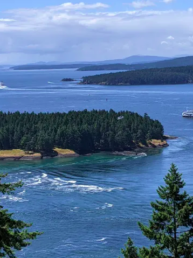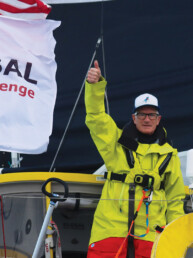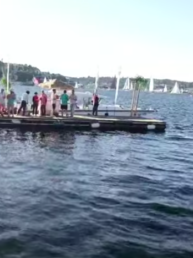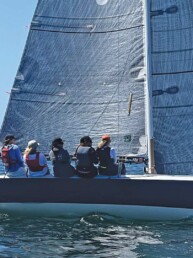From Ocean Racer to Liveaboard Cruiser, a Legend Lives On
This article was originally published in the January 2022 issue of 48° North.
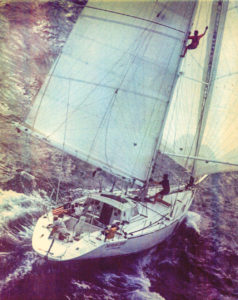
The last time we checked in with 48° North, we were cruising on our 1980, 39-foot sloop, Louise. I think we were in Tahiti when we sent a snapshot of our lives to this beloved publication. We were about halfway into a 2-year cruise that took us from Seattle to Baja and the Sea of Cortez, across to the Marquesas, Tuamotus, Tahiti, then north to Hawaii, and back home to the Pacific Northwest.
We returned in the late summer of 2019 only to begin a whole new adventure of the maritime variety — although this adventure takes place on land. Namely, in our backyard in Port Townsend where we have become landlubbers for the moment.
In a recent bout of nostalgia, I was re-reading the blog that I kept for friends and family during our cruise. Specifically, it was amazing to read my last post because the dream that was just a twinkle in our eyes back then has now come to fruition.
What’s changed for us since then? Let’s time travel for a moment, back to the summer of 2019 to our last anchorage, and location of my last blog post, before the 3-week passage home to find out:
Nawiliwili Bay, Kauai (summer 2019)
The end of the cruise doesn’t really feel like a hard and final end because the cruise has fundamentally changed how we want to structure our lives. It has set us on a path. We’ve started to reflect a little, here and there, about how the last two years have changed us. Mostly we talk about how the cruise has made us realize that anything is possible. We can, and we should, live our dreams, and if those happen to go against the societal grain, there’s no rules against that. And if you tend towards relishing being unconventional, as we admittedly do, it’s a bit of a thrill. We’re dreaming and scheming of a future in which we live, somewhere in the Salish Sea, on a boat powered by solar, wind and hydro that Matt has built himself (more on that in a bit). We both want to work for ourselves so we’re able to try to find a balance between vocation and everything else life has to offer. We want to live minimally and frugally so that we can afford more free time. Since we hope to work for ourselves, we hope to also be able to pull up our anchor and go exploring anytime. All of British Columbia and Alaska awaits to the north and the rest of the planet to the south. We’re both full of conviction to make this vision reality, though our dear friend Salty might read this and, with a roll of his eyes say, as he has said before, “Such bums!”
Maybe he’s right.

Currently, we’re both full of the energy that comes with taking the first steps toward a dream. For me, the dream is an idea that’s been taking shape since the beginning of our cruise. I want to create a program in which middle school science students create wildlife habitat in their schoolyards as a part of their science curriculum. For Matt, the dream is an object weighing 15 tons.
Recently I have observed Matt at various times of the day and evening, sitting with a half smile on his lips, a twinkle in his eye, legs crossed and a Birkenstocked foot gently swaying and betraying an inner glee. I know during these times that he is thinking about “The Hull.” Matt recently took offense that I refer to it as The Hull. I asked him why this offends him and his indignant reply was that The Hull sounds so soulless. This is not just any hull. It has a storied past and hopefully a storied future with us. So let me tell you a little about The Hull.
The Hull is actually a tiny bit famous. It was designed by Rodger Martin and built by Mike Plant back in the 1980s. After building it, Mike Plant sailed around the world on it twice, beating the American record for circumnavigation of the planet during the first Vendee Globe. The Hull is Duracell. There’s an excellent documentary, “Coyote: The Mike Plant Story,” about Mike Plant that features footage of Plant building and racing the young Duracell.
Duracell was eventually sold to a sailor from Seattle named John. John raced Duracell in the Pan Pacific Race, coming in first place. He then began a solo, non-stop circumnavigation of the planet on Duracell, but somewhere near the equator he had a collision with a cargo ship (shudder) and was dismasted. Apparently the hull didn’t sustain much damage as the bowsprit took most of the blow. Duracell was then moved to John’s backyard in South Seattle where it has been for the last twenty-five years, being washed by the Seattle rain.
Matt was surfing the Sailing Anarchy sailing forum recently when he came across John’s post with the title: “MIKE PLANT’S OPEN 60 ‘DURACELL’-What Next?” In the post, John went on to say: “I love that boat. I can’t imagine a more easily handled, sea kindly, safe, proven, shorthanded boat capable of sailing anywhere on earth. So a refit for a solo circumnavigator? Or shorthanded go anywhere?”
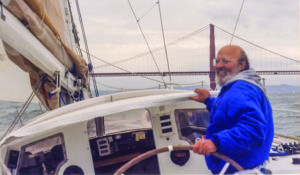
Matt saw this post and immediately turned to me and said: “I found our next boat.” The wheels began turning. John is interested in a partnership to restore Duracell to glory and get her out on the water again. He is considering giving us the boat. This would all be in exchange for some sailing time once it’s all fixed up and launched.
So you might ask: why this boat exactly? What makes Duracell so special? Matt says it’s because it’s the most solid, safe, well-built, fast boat out there that he knows of: a very special shell that we can make our home. In short, he wants to turn this legendary, old racing boat into a fast, comfortable, safe cruiser. He’s in love. He spends every evening drawing out plans, which completely absorbs him, only punctuated by occasional statements that are sometimes encouraging to me (“this is going to be the coziest boat in the world!”) and other times, a little alarming (“Ohh! It only weighs 30,000 pounds!”) According to Matt, we will be able to zip down to the Channel Islands (for example) in five comfortable days. Seattle to Hawaii? A couple comfortable weeks.
Hully cow (forgive me).
Now back to the present: fall of 2021. Duracell is in our backyard, snug and dry under a bow shed that Matt built for it. Back when I wrote that starry-eyed blog post, we had no idea that it would take two years from first meeting John and Duracell to moving the boat to our yard. In short, it took some time to gain John’s trust that we are not just dreamers, plus a global pandemic slowed things a bit. But Duracell is in our yard now and about six months along in the process of being turned into our dream cruising vessel. We still pinch ourselves almost daily that Duracell is ours and that this dream project is happening. And boy is it happening. It’s full on.
Duracell was built to win solo circumnavigation ocean races, so the interior is spartan to say the least. It has nothing that makes it a liveable, comfortable home (no galley, no settees, no quarter berths, no head). Basically, an unfinished interior — which is exactly what we want. A blank slate.
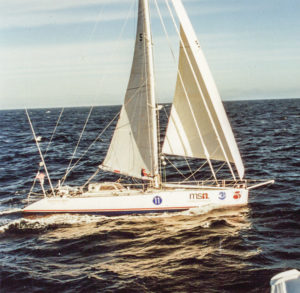
And what was inside Duracell has now been removed. The first two months of The Duracell Project have mostly been removing stuff from the interior and exterior. We removed all the original wiring, electronics, plumbing, batteries, tanks, an old DC distribution panel, old sails, and two engines. We’ve hauled several truckloads of stuff to the dump and there is a small mountain range of salvageable things in our carport that we will either sell or put back on the boat. Of all the things that came off or out of the boat, a few notables are: four petrified rats, lots and lots of outdated 1990s electronics including a weather fax, some 25-year-old sea water in the ballast tanks, a Yanmar engine, and an old Balmar generator.
Removing the two engines was…a process. The engines were located under the cockpit and there was no way we could carry them out of the engine room and out the entrance. So, we cut out the cockpit floor. Then we built a series of gantries to get it out of the engine room and into the cockpit. From there, we moved it aft to the stern of the boat and used the biggest gantry to get it off the boat. And we did all this only dropping an engine once! There was, thankfully, no damage to the engine or the boat. We think that says a lot about the boat. We’ll try to sell the Balmar to add some dollars to the Duracell kitty and we’ll also sell the Yanmar or possibly convert it to a generator for a serial hybrid propulsion system.
Then we cut out the rest of the cockpit, including the cockpit benches, the sides, and the aft ballast tanks. Now that the cockpit is gutted and there’s basically a gaping hole where it used to be, we can really start to envision how we will rebuild it. And we do have plans. We’ll tell you more about them in our next article, so stay tuned!
Editor’s Note: Janneke and Matt are putting an impressive amount of fascinating and informed video content on their youtube channel, The Duracell Project. You can check it out yourself at: www.youtube.com/c/TheDuracellProject, but here’s their first video:

